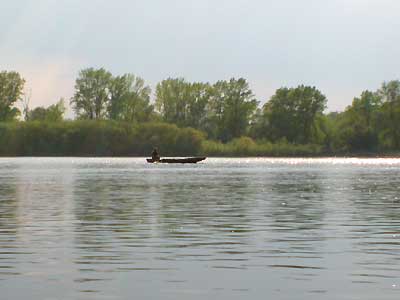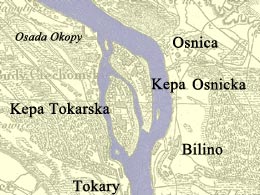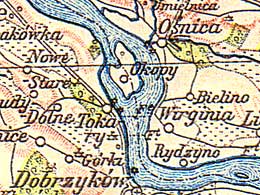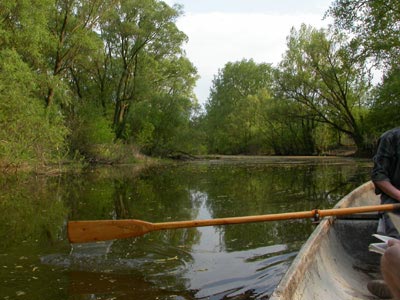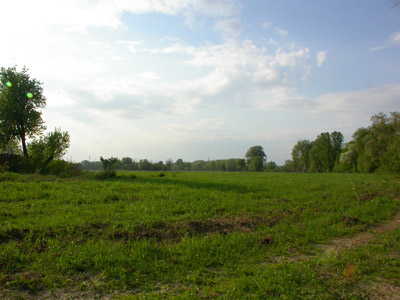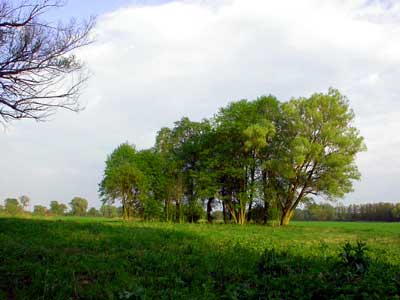 |
 |

|
Kępa Tokarskaor: A visit to the Kępa Tokarska and the Kępa Ośnickaby Jutta Dennerlein |
|
|
Jutta Dennerlein lives near Munich, Germany. Her mother's ancestors seem to have always lived along the Vistula and someday also came to the islands near Płock. |
|
|
Get document KępaTokarska_EN.pdf - Size 0.5 MB |
|
|
The threatening thunderclouds of the hot afternoon in May 2006 disperse just in time with the appearance of the boat, which comes off the silhouette of the island and crosses the stream in a straight line. The boat is a wooden rowing boat, as they are often seen on the Vistula. It is steered by Grzegorz. His destination is the right bank of the Vistula, where Paweł Kowalski and me are already waiting for him. |
|
|
The boat is coming |
|
|
Grzegorz's hobby is to grow plants on the island. He has promised his cousin Paweł to show us around on the island. The island, that's for me the Kępa Tokarska, for Paweł it is the Kępa Ośnicka and we are both right.
In former times, southeast of Płock, where the Vistula turns sharp north for some five kilometers before it resumes near Płock it's general northwest course, there where two islands in the middle of the stream. The islands were situated close together. Maybe they had emerged from the same piece of land. Both islands were Kępas, since they were covered in trees and each of them held room for 3 to 4 farms. A long, long time ago they had been separated from the banks by the incalculable stream and for a long time the Vistula gave no preference to any of the created arms. It streamed past each of the islands as well as between them. So the southwestern island, which lay nearer to the left bank, was named after the estate Tokary and became the Kępa Tokarska. The northeastern island, nearer to the right bank, was named after the nearby place Ośnica and became the Kępa Ośnicka. |
|
|
Both Kępas in 1839 |
In 1920 both Kępas had grown together. |
|
At the end of the 19th century the Słownik geograficzny Królestwa Polskiego gives the following description: " ... in the neighbourhood of Ośnica two large islands: Tokarska and Ośnicka divide the Vistula into three arms and a stream goes in the middle of the islands by a narrow strip of water. In the vicinity of Płock, that lies with a picturesqueness on the high right bank, the island helps to cross the river. ..." [1] About the end of the 19th century the two islands had grown together and formed one big island. However the two parts of the island were still separated by an administrative border, which run along the middle of the stream and right across the island. So the northeastern part of the island belonged to the community of Bielino and to the Lutheran parish of Płock, whereas the southwestern part of the island belonged to the community of Dobrzyków and to the Lutheran parish of Gąbin. This administrative division of the island might not have bothered the islanders too much. Their neighbors were the people who - like themselves - had learned to arrange their lives with the extreme conditions of the Vistula and shared a common destiny with them. Social contacts were kept up to both sides of the Vistula, since both banks could easily be reached by boat or, in winter, directly by their horse-drawn-sleighs. Only for a short time in spring the islanders were completely isolated. That was when the drifting ice flows made it completely impossible to cross the Vistula.
Meanwhile we have reached the island and Grzegorz skillfully navigates the boat through a dead arm with standing water, which seems to lead to an inner part of the island.
Mysterious approach, ... It is quiet - very quiet. Overhanging or half sunken trees give an impression of primeval times. Single water birds flying up and the secret paths of the beavers show, that humans are not often disturbing here. Finally we reach the landing place, a narrow strip of sand at the bank. A small opening in the trees shows a small meadow and a wooden palisade. Have humans entrenched themselves behind this palisade against the advancing wilderness? The impression of an outpost of civilization soon disappears with the sight that now reveals: Vast, fruitful land. Only at the edges encircled by trees and bushes. Land that shows the traces of human work and machinery. Isolated groups of old trees give the impression of a park like scenery. I never would have expected that the island would be so extensive!
... then: vast land The size of the island also unfolds during our tour, which leads us to the northern part of the island. Who have been the inhabitants of the island? Why did they live there?
The oldest known contract for the Kępa Ośnicka goes back to the year 1759. As Albert Breyer writes [2], the lease contract was made by Probst Wolicki, the authorized Kommissarius of the bishop of Kujawia. In his unpublished copy of the Polish document Albert Breyer also noted the names of the other party to the contract: "... Komisarza Biskupstwa Kujawskiego daie Kontrakt Holendrom, którzy osiadnią na Kępie Ośniekiej, to iest: Chrysostomowi Gołębiowi, Michałowi Bleykowi, Jordze Rynasowi, Jordze [Pucowi, Penowi, Ducowi, Dwowi ?], Michałowi Pekrulowo, Michałowi Malminowi" It can be assumed that these are forms of the names which we know from the later church books. Probably Taube, Bleyke, Rynas, [Putz, Penner, Dux, Duwe?], Pekrul and Malmin. Since the named Holenders are addressed as already living on the Kępa Ośnicka, this was certainly not the first contract made for these islands and this certainly was not the first Holender settlement in this area.
Landscape garden But have these Holenders really been Dutch? Or were they from Pomerania or Mecklenburg? Or were they simply Polish, since they lived under the Polish crown? For the settlers who came to the banks of the Vistula in the 18th century or earlier the question of nationality was not so important. Much more important for them were the question of religion, of personal freedom and of economic welfare, since they had set off from their original homes because their religious conviction had been suppressed, because they wanted to escape from serfdom and because of economic plight. Their origin, their way through history and through Europe can only be clarified by the research of all the individual family names.
Meanwhile we have continued our stroll around the island. We take the direct way across the vast meadow in the center of the island. A somewhat coarse plant catches our eyes. It is extremely frequent on this meadow, towering over the grass and already showing hairy, blue/purple colored buds. Grzegorz knows what it is: ogóreznik. Ogórek means cucumber. Has this something to do with cucumbers? But of course, it is common borage (Borago officinalis). The German as well as the Polish name means "cucumber herb", because the leaves taste like cucumber. I have never seen common borage growing wild and in this quantity. It is probably the descendant of a long gone garden where pot and medicinal herbs were grown. |
|
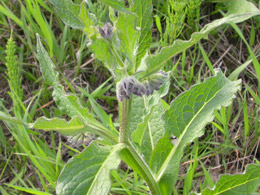
Common borage (Borago officinalis) |
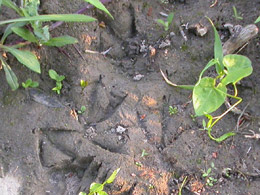
Footprints |
|
The meadow shows some more specific features. The last flood was about three weeks ago and the island must have been completely under water. The ground has dried now and can be walked on. But the many uncovered places in the meadow show that the ground must have been extremely soft at some time. Innumerable prints of animal feet, mostly birds, run all over the place. Especially numerous are the traces of storks. After the watermark had fallen, the island with many remaining puddles must have been a real paradise for frogs. That was before the storks had found the place. But the storks have left over enough frogs, they jump out of the grass with every step we make. |
|
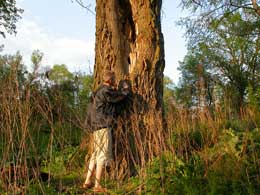
Many things catch out attention ... |
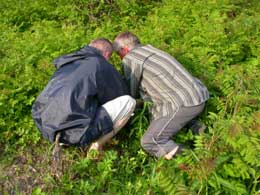
... some of them need root deep investigation |
|
Grzegorz points us to more strange plants. A row of trees, which is still without leaves, whereas the other trees already shine in their fresh spring colors. These from the distance rather insignificant trees show by nearer investigation 6-7 centimeters long thorns. The grass underneath them is covered with shiny dark brown pods, most of them about 25 cm long. I think I have seen this kind of pods before in the Mediterranean. But how should carob trees have come to this island? How did these trees survive the heavy frost? Questions, not easily answered. Later research showed that those trees were not really carob trees or St. John's bread (ceratonia siliqua) but a frost resistant tree of the same family: Honey locust (gleditsia triacanthos). This tree is native in North America not in Europe. It can be imagined that these trees have been planted by someone who liked them as an exotic addition to his garden. Parts of the pod and the grounded seeds could have been used as a sweetener or as a substitute for cocoa. The rest of the pods was good feed for the cows. |
|
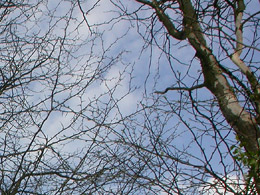
Carob trees? |
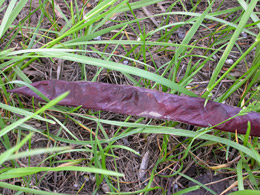
Pod |
|
Not far from the supposed carob trees we find the rests of a cellar and other traces of human housing. Now we realize, that the park like groups of trees actually point to the places where houses had stood. On artificial little hills (Wurten) big lime trees and chestnut trees surround what is left over from the houses. Certainly there were wooden houses. Everything except for the stone structures has disappeared. |
|
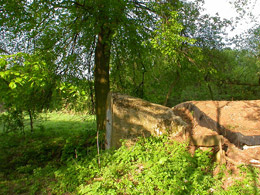
The cellar is still there |
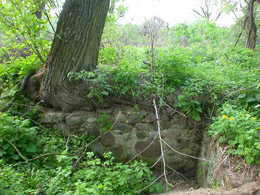
Rests of walls |
|
Sometimes we also find metal parts around the houses. At the next place of a house we find a rather large piece of metal and we puzzle over what it might have been. Grzegorz has the most experience in farming and finally says that it could be a part of a horse mill. I think he is right about it, because horse mills have been in use on almost every farm. Most times they were used to grind rye to feed the animals with it. We put the part back where we found it. We don't think of taking it with us. This would somehow be like theft from the people who had been living and working there. And apart from that, in a museum you would not take the exhibits either, would you? |
|
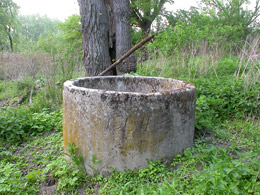
Well dated 1904 |
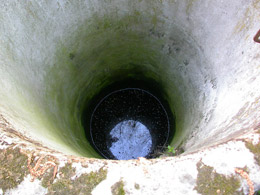
Is this water drinkable? |
|
At this farm we also find a well with the inscription "1904" at it's side. The cement tube of the well is still intact and the well has water. But what else do we know about the people whom we are looking down their well?
The island with it's surface of ca. 140 hectares offered sufficient space for about 6 families. This number is indicated by the contract of 1759 and it seems that this number did not change much within the next 180 years. But the names of the inhabitants did change within this time period. So the church books of the time between 1760 and 1800 show the names: Zittlau, Taube and Dobslaw. The number of inhabitants for the Kępa Ośnicka in the year 1799 is given with 4 families and 21 souls [3]. For the time after 1800 the names Rossol, Schwentke, Tews, Jabs and Golnik are mentioned in the church books of Płock and Gąbin. In 1882 the Słownik geograficzny Królestwa Polskiego notes: Tokarska Kępa 4 houses, 48 inhabitants and 101 Polish morgen (56,54 hectares) of land and Ośnicka Kępa: 4 houses, 30 inhabitants and 65 Polish morgen (36,39 hectares) of land.[4] In the year 1945 finally the following names are mentioned as owners of land on the Kępa Tokarska: Rossol, Schwentke, Tews and Jabs; on the Kępa Ośnicka: Tews, Rossol, Schwenke, Eichmann and Jabs [5]. This change of names does not seem unusual for a period of 180 years and this very small number of households. Nevertheless it seems that all Kępas have experienced more change than other places, especially within the 18th century. Maybe this can be explained by the rough and insecure living conditions on the Kępas. Besides the "usual" name change by lack of male descendants there might have been a tendency to leave the Kępas for a saver farm on the banks of the Vistula. |
|
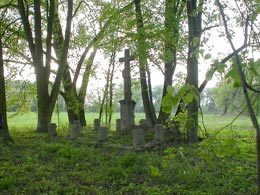
Cemetery at the Kepa Ośnicka |

The flood has left high water marks at the trees |
|
Looking at the flood marks which we can see on the trees of the small cemetery at the Kepa Ośnicka, we can easily imagine that all of the island regularly gets flooded ( in spring 2006 the marks at the trees reached about 1.5 meters height). During the time of the floods only the houses on their Wurten offered comparatively save being. Only comparatively save, since the water which passed the houses was not the slow flow of a huge flooding area but the angry roaring of a stream carrying high water. Grzegorz still knows one of the anecdotes being told about the Germans on the island. I liked this anecdote because it fits to my image of the Niedrungers: According to this story, the inhabitants of the island were rather suspect for the German administration after 1939. Too independent were the islanders on their protected little realms. Too difficult was the observation of the island. But it was not political intrigue which the islander were suspected of. The Nazi administration suspected them to be keeping up their trade with Warszawa using the river and the dark of the night for it - they were suspected of being smugglers. The trade relations to the factories in Warszawa had a long tradition with the islanders. Now Warszawa was within the boundaries of the Generalgouvernement and this was like a foreign country. But who gives up old habits and a good trading market only because the political structure has changed once again? |
|
|
After the last war the Kępa and some areas at the left bank of the Vistula became property of the Polish Army. Some cement roads at the left bank still remind of this time. For the Polish Army the isolated location of the island obviously was also very welcome.
Today the island is leased to a farmer from Ośnica. The natural boundaries of the island allows that his pigs can stroll free all over the island. During our hike we were followed in very great distance by a sow and it's piglets. The piglets could only be seen as far away small, pink backs in the grass. Only after sow and piglets were behind the palisade and in safety, we went through a closer examination by a group of "youngster" pigs. |
|
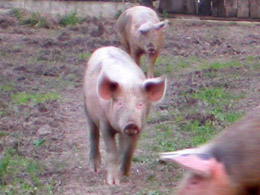
Curious pigs |
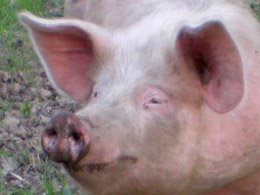
Satisfied pig |
|
It seems that on today's maps the island is usually only called Kępa Ośnicka. Even the people living at the right bank of the Vistula don't know anything about a Kępa Tokarska. They say, that this island must have disappeared a long time ago. But this cannot be true, since up to 1945 both names are given as places of birth or places of dwelling in the records of the different Gminas - Paweł has looked this up! It seems to be an one-island-two-names-problem. I think that it would be nice, if the name Kępa Tokarska would continue to be used in the future. After all the Kępa Tokarska might be the only Kępa which is mentioned in a theater play. [6] Maybe the passing on of the interesting story of both islands can help a little bit to keep the name in memory and to maintain it's usage.
So our visit to the Kępa Tokarska and the Kępa Ośnicka is over. We have seen about half of the island and it has been a very impressive and informative tour. I'm really glad that Paweł was able to organize it during my stay in Poland. Grzegorz will stay on the island and we are already awaited by his other cousin Marian, who will row us back to the bank. |
|
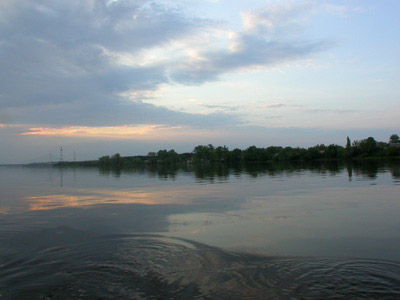
On our way home |
|
|
[1] Sulimierski, Filip: Słownik geograficzny Królestwa Polskiego i innych krajów słowiańskich, Warszawa, 1880-1914, Vol. XIII, page 583; Translation by Paweł Kowalski [2] Breyer, Albert: Aus der Geschichte der Niedrungsdörfer der Gemeinde Gombin, Teil III in: Evangelisch-lutherischer Weichselbote, 5. Jg., Nr. 15 of 2. Aug 1936 [3] Quednau gives for the year 1799 the numbers - Białobrzegi (11 families, 56 souls), Osnitzer Kämpe (4 families, 21 souls) and Kämpe Lyszyno (5 families, 25 souls). [4] Sulimierski, Filip: Słownik geograficzny Królestwa Polskiego i innych krajów słowiańskich, Warszawa, 1882, Vol. III [5] Bundesarchiv, HAST 14 - Kreis Schröttersburg and HAST 14 - Kreis Waldrode. [6] In his drama "Kreuz an der Ostsee" the author Zacharias Werner uses the scenery of the Kępa Tokarska for a part of the story. |
|
